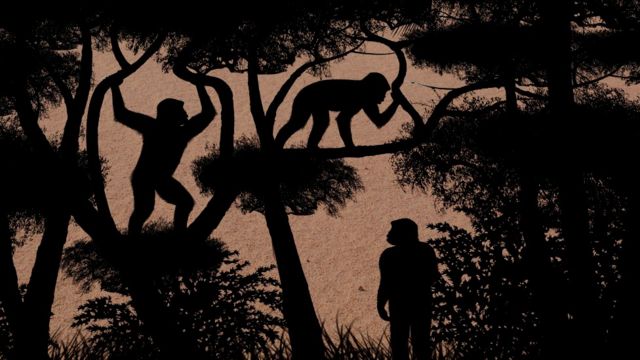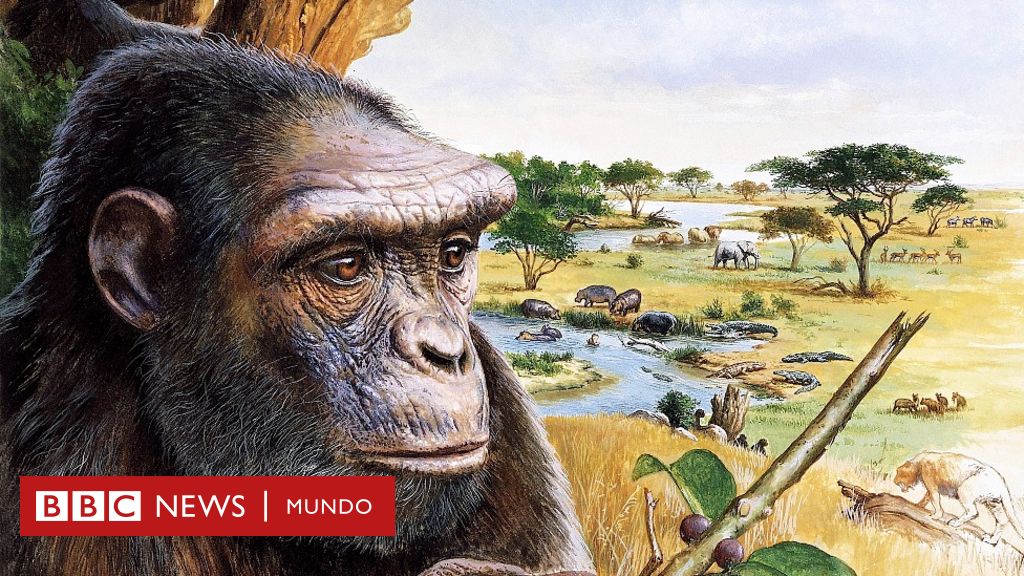- Draft
- BBC News World

image source, Courtesy Frank Guy
Reconstruction of different movement patterns in the Djourab Desert (Chat). Sabine Rifat, Guillaume Daver, Frank Guy / Paleoprim / CNRS – University of Poitiers / MPFT
According to a new study, the oldest known ancestors of humans already walked on two legs.
The conclusions are based on an analysis of fossilized bones discovered in Chad 20 years ago, which have now been analyzed.
According to the researchers, the remains belonged to a man they called Sahelanthropus tsatensisLived six to seven million years ago.
It would be the oldest known member of the hominin lineage, the evolutionary branch from the common ancestor of humans and chimpanzees to modern humans.
When one of the main bones found, the skull, was analyzed in 2002, scientists nicknamed it the owner. Toumaï means “faith of life” in Chadian..
New study Now published in the journal Nature is based on an analysis of other bones, including the femur.
Whether Sahelanthropus tchadensis was bipedal has been debated for years. But the authors of the new work, from France and Chad, say they finally have an answer.
When were fossils discovered?
In July 2001, the bones were discovered by researchers from France and Chad during an expedition to the Djourab Desert in the north of the African country.
Since when study In the skull, scientists led by paleoanthropologist Michel Brunet of the University of Poitiers in France indicated that, like a chimpanzee, Touma had other characteristics of later hominids, such as teeth, despite his smaller brain size. and face.
They also mentioned The orientation of the hole at the base of Toomai’s skull indicates that he walked upright.
image source, Science Photo Library
When the skull was analyzed in 2002, scientists gave its owner the nickname Duma, which means “hope of life” in Chadian.
On the same 2001 expedition, researchers collected hundreds of other fossils.
The new study is based on limb remains, including “One part is the left femur (thigh bone) and two are the left and right ulna (the ulna, or ulna, is one of the two bones of the radius forearm; it makes up our elbow).“, the authors of the work point out in a popular article on the conversation site.
The femur was studied for the first time in 2004 by Aud Bergeret-Medina, a student at the University of Poitiers.
Roberto Macchiarelli, a paleontologist and the student’s supervisor, agreed that the bone probably belonged to S. tchadensis. However, it has not been proven that the femur, ulna and skull belong to the same individual.
Why did scientists take so long to study other remains found in Chad?
Research on endpoints did not gain momentum until 2017.
“It’s not our priority,” said Frank Guy, the Poitiers paleoanthropologist who led the latest research. NatureNature.
In their article in The Conversation, the authors of the new study say, “For a variety of reasons, the amount has been significantly reduced, including priority given to field studies of other post-cranial remains and other work, as well as difficulty.” To analyze this fragmented content requires additional insight. Started back in 2017, it took five years to complete.”
image source, Christian Jecko / Science Photo Library
It could have been Toumai. Description of Sahelanthropus tchadensis. Christian Jekov.
What is the proof that Thumai walked upright?
The oldest bipedal fossil ever described is the six-million-year-old Ororin tugenensis, discovered in Kenya.
However, the authors of the new study point out that features of the femur and ulna found in sat show their owner’s ability to walk upright.
Scientists compared these bones to those of a wide range of animals and other human ancestors.
“Since the preservation of these long bones is not very good (for example, the femur, which has been lost in both legs), abstract analysis does not provide reliable interpretations,” the authors note.
“For this reason, we study them from all angles, both their external morphology and their internal structures.”
The researchers say they used more than 20 criteria to compare it with other bones from current and fossil specimens.
“Taken in isolation, none of these criteria can be used to propose a definitive interpretation of the subject matter.”
However, they add, In total, HeThe found writings show that The “Sahelanthropus practiced a typical bipedal gaitthe mind“.
The authors rely on features of the femur closer to humans than to great apes.
Spanish scientist Pablo Pelés-Campomanes is a researcher at the Museum of Natural Sciences in Madrid and one of the authors of the 2002 study of the Touma skull.
“The fragment of the femur they have presents a series of morphological characteristics, such as the area of the bone, the thickness of the cortical layer of the bone and the shape of the various muscle insertions compared to other species. Different locomotions, it is possible and rational to interpret this species as bipedal at most,” the scientist explained to BBC Mundo.
“As for the ulna, it lacks bipedal characteristics. The article, on the basis of different morphological characters (curves, insertions, etc.), may belong to a species with arms adapted to life with an important woody component.”
“Thus, the combination of the two bones with previous studies of the skull would indicate that this is a bipedal species that has retained osteological adaptations related to arboreal behaviors.”
Sahelanthropus could walk on two legs while on the ground and easily climb trees.
image source, Franck Guy/PALEVOPRIM/CNRS – University of Poitiers
Two views of the femur (left) and forearm ulna of Sahelanthropus disatensis discovered in 2001.
Frank Guy says, “When on the ground they preferred bipedal locomotion. But sometimes they chose to climb. All the characteristics point to this type of behavior.”
According to the study, Pelaez-Campomanes indicated that Sahelanthropus would have formed part of the so-called hominins, a subfamily of hominids.
“In simple terms and according to the interpretations of this article, Sahelanthropus will be the first representative of hominins to include the clade that includes the genus Homo,” explained the Spanish scientist.
“One of the traits that members of this hominin clade must have is the acquisition of bipedalism, so it’s important to consider this species as a hominin.”
Why does the study create controversy?
Daniel Lieberman, a paleoanthropologist at Harvard University who was not involved in the research, notes in an article in Nature accompanying the new study that the Sahelanthropus femur “looks more like a bipedal hominin than a quadrupedal ape.”
However, the debate continues.
Already in 2020 Aude Bergeret-Medina and Roberto Macchiarelli published a work based on measurements and photographs, in which they argued that the owner of the famous femur did not walk upright.
According to an article in the journal Nature, Macchiarelli is not convinced by the new study.
The femur’s features, described as a bipedal sign, may be the result of compression from millions of years of sedimentation, the researcher says.
Fred Spoor of the Natural History Museum in London told the journal New Science the authors of the new study. “A good case” for bipedalismBut the debate is likely to continue.
Kelsey Pugh of the Natural History Museum in New York said, “It will be imperative that separate paleoanthropologist teams study these fascinating fossils in the coming months.”
Now you can get notifications from BBC World. Download the latest version of our app and activate it so you never miss our best content.
Eden Hayes
"Wannabe gamer. Subtly charming beer buff. General pop culture trailblazer. Incurable thinker. Certified analyst."





